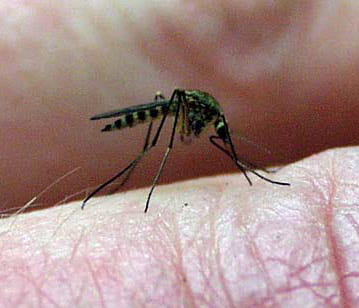2012 is the worst year on record for West Nile Virus (WNV) in the United States since the disease first appeared in New York in 1999. Forty-seven states, including all states in the Western Great Lakes have reported cases of both infected birds and humans and all 50 states have reported infected birds.
West Nile Virus is transmitted by the bite of a mosquito. While several species of mosquitoes can harbor the disease, the most common species we are likely to encounter in urban and suburban areas is Culex pipiens, the northern house mosquito. Culex and the other suburban mosquitoes prefer to breed in small containers or stagnant water with lots of organic debris like animal droppings or decaying leaves. The disease is transferred when a mosquito bites an infected bird. That mosquito can then pass the virus on by feeding on other birds, or susceptible mammals including humans.

Unfortunately, the disease can heavily impact bird populations. Crows are particularly sensitive to WNV and populations in North America declined by as much as 45% after the WNV epidemic in 2002. Robin populations were increasing in the 1990s, but have leveled off since the introduction of WNV.
Increased biodiversity provides an advantage against infection. Scientists have shown that areas with more bird species tend to have fewer mosquitoes carrying WNV and fewer cases of human infections (Ezenwa et al., 2006; Swaddle and Carlos, 2008). Researchers believe the effect is related to the susceptibility of different bird species to the virus. Some birds like American robins are known to be good hosts and are better at spreading the disease because mosquitoes seem to like to feed on them and they are better carriers than some other species. According to Tony Goldberg, an epidemiologist at UW—Madison, robins are good hosts and can act as “super-spreaders” of the disease. In areas with lots of robins and few other bird species there are higher total number of human infections. But not all bird species are good hosts for the disease so it is thought that higher bird diversity reduces infection rates because mosquitoes are less likely to encounter a good host and therefore less likely to become infected and transmit the disease. The presence of birds that are poor hosts reduces or “dilutes” transmission rates of the disease between birds and also to humans. Similar results have been shown for other animal vectored diseases like Lyme and Hantavirus (Keesing et al. 2010).
Controlling mosquitoes
- Large ponds and healthy wetlands contain fish and invertebrate predators like dragonfly larvae that feed on mosquito larvae that naturally keep mosquito populations in check. The problem mosquitoes are those that prefer to breed in stagnant water like puddles, tree-holes, and other small containers.
- Make sure you are not inadvertently providing mosquito breeding containers. Be sure to make sure your gutters are not clogged and that old tires or children’s toys or other containers cannot hold water.
- Empty containers of water such as bird baths, kiddie pools, plant trays, twice each week.
- Consider using mosquito dunks that contain Bt in yard water features that are too large to empty each week. The dunks contain the bacteria Bacillus thuringiensis Israliensis, which produces a toxin that kills mosquito larvae, but is non-toxic to other wildlife.
- Where long sleeves and long pants and use CDC recommended mosquito repellants
- Fans can be effective at deterring mosquitoes in a small area such as on a deck or a patio area. Mosquitoes are weak flyers and fans will keep them at bay. Fans also blow away exhaled carbon dioxide that attracts mosquitoes.
Increasing backyard bird diversity
- There is no reason to stop feeding or watering birds because the disease can only be transmitted by the bite of a mosquito. The disease cannot be transmitted from bird to bird, from birds to people or from people to people.
- Provide a variety of feeders and feeds that attract different species.
- Create as much quality habitat as possible. Include vegetation, shrubs, and trees that provide forage and cover from predators.
- Try to match natural habitats by planting vegetation that includes a diversity of plants and plant types.
- Provide bathing and watering areas, but be sure to keep them mosquito free.
- Keep your feeders and feeding areas clean to prevent the transmission of bird diseases. There are no known cases of West Nile transmission between birds in nature, but stressed, injured, or birds sick with other diseases will be more susceptible to West Nile infection from mosquitoes.
References
Ezenwa, V.O. et al. 2005. Avian diversity and West Nile virus: testing associations between biodiversity and infectious disease risk. Proceedings of the Royal Academy: Biological Sciences 273:109-117.
Kessing et al. 2010. Impacts of biodiversity on the emergence and transmission of infectious diseases. Nature 468: 647–652
Swaddle JP, Calos SE (2008) Increased Avian Diversity Is Associated with Lower Incidence of Human West Nile Infection: Observation of the Dilution Effect. PLoS ONE 3(6): e2488. doi:10.1371/journal.pone.0002488
Zimmer, C (2012) West Nile Virus: The Stranger that Came to Stay. Discovery Magazine “The Loom” Blog. http://blogs.discovermagazine.com/loom/2012/08/17/west-nile-virus-the-stranger-that-came-to-stay/
